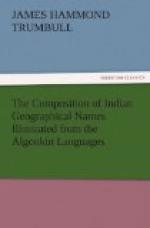[Footnote 1: Mill’s Logic, B. I. ch. viii.]
[Footnote 2: Max Mueller, Science of Language, (1st Series,) p. 292.]
Not that personal or proper names, in any language, were originally mere arbitrary sounds, devoid of meaning. The first James or the first Brown could, doubtless, have given as good a reason for his name as the first Abraham. But changes of language and lapse of time made the names independent of the reasons, and took from them all their significance. Patrick is not now, eo nomine, a ‘patrician;’ Bridget is not necessarily ‘strong’ or ‘bright;’ and in the name of Mary, hallowed by its associations, only the etymologist can detect the primitive ‘bitterness.’ Boston is no longer ‘St. Botolph’s Town;’ there is no ‘Castle of the inhabitants of Hwiccia’ (Hwic-wara-ceaster) to be seen at Worcester; and Hartford is neither ‘the ford of harts,’ (which the city seal has made it,) nor ’the red ford,’ which its name once indicated.
In the same way, many Indian geographical names, after their adoption by Anglo-American colonists, became unmeaning sounds. Their original character was lost by their transfer to a foreign tongue. Nearly all have suffered some mutilation or change of form. In many instances, hardly a trace of true original can be detected in the modern name. Some have been separated from the localities to which they belonged, and assigned to others to which they are etymologically inappropriate. A mountain receives the name of a river; a bay, that of a cape or a peninsula; a tract of land, that of a rock or a waterfall. And so ‘Massachusetts’ and ‘Connecticut’ and ‘Narragansett’ have come to be proper names, as truly as ‘Boston’ and ‘Hartford’ are in their cis-Atlantic appropriation.
The Indian languages tolerated no such ‘mere marks.’ Every name described the locality to which it was affixed. The description was sometimes topographical; sometimes historical, preserving the memory of a battle, a feast, the dwelling-place of a great sachem, or the like; sometimes it indicated one of the natural products of the place, or the animals which resorted to it; occasionally, its position or direction from a place previously known, or from the territory of the nation by which the name was given,—as for example, ‘the land on the other side of the river,’ ‘behind the mountain,’ ’the east land,’ ‘the half-way place,’ &c. The same name might be, in fact it very often was, given to more places than one; but these must not be so near together that mistakes or doubts could be occasioned by the repetition. With this precaution, there was no reason why there might not be as many ‘Great Rivers,’ ‘Bends,’ ‘Forks,’ and ’Water-fall places’ as there are Washingtons, Franklins, Unions, and Fairplays in the list of American post-offices.
With few exceptions, the structure of these names is simple. Nearly all may be referred to one of three classes:




